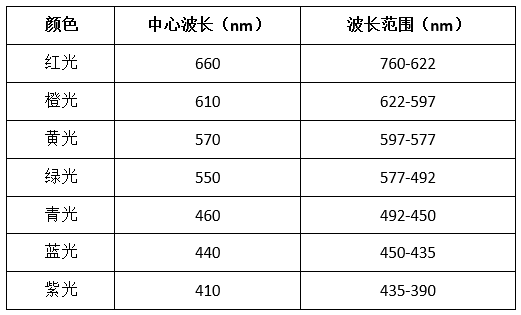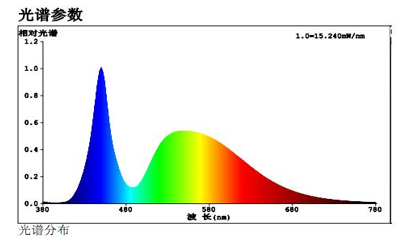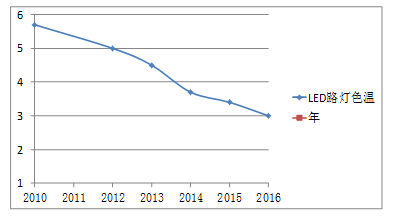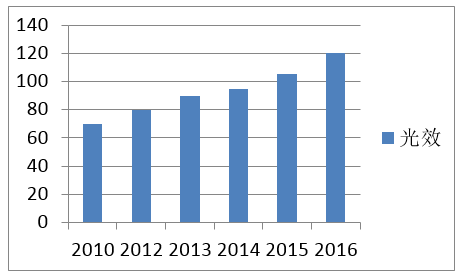
Privacy statement: Your privacy is very important to Us. Our company promises not to disclose your personal information to any external company with out your explicit permission.

1 Overview
In recent years, due to the advantages of energy saving and long life of LED lighting products, indoor lighting has widely replaced incandescent lamps and fluorescent lamps; in the outdoor, some high-quality LED street lamps have been fully qualified for road lighting, and also show some unique advantages. For example, high color rendering index, long life, etc., but the penetration of LED street lights in rain, snow, fog weather is still insufficient, is the main factor affecting LED lighting in outdoor applications.
2, road lighting requirements for penetration
The lighting fixtures on the road are mainly divided into automobile lights and street lights. At present, the main lights and street lights are mainly yellow light. The signal light serves as an indicator to guide, direct and alert the pedestrians and drivers on the road.
2.1 headlights
Heavy fog (rain, snow) is a major obstacle to vehicle travel. When the vehicle encounters heavy fog (rain, snow), it often turns on the front and rear fog lights, allowing a cluster of brilliant yellow lights to open, both illuminating the road ahead and marking its position, making the oncoming vehicles Pedestrians can quickly avoid the collision accidents through thick fog screens. The light from the fog lamps of the car is yellow light, which is the best choice after careful research by scientists.
In order to make the car headlights brighter, the 28-year-old Shaoxing owner, Mr. Chen, spent all his money to change the high beam, low beam and fog lights into 6000K high color temperature xenon headlights. "It's really bright!" Mr. Chen said that after changing to a xenon lamp, when the weather is good, as long as the lights are turned on, "can not see the eyes," he is very satisfied. But when he drove out to play, he was attacked by heavy fog. He opened the xenon lamp with ease, but unexpectedly, "there was nothing completely white and nothing could be seen." Since the visibility is less than five meters, the xenon lamp is useless, and he can only move a little by feeling. After a few minutes, I suddenly heard the car in the back and slammed the horn. He stopped and looked. "Oh my God, the front of the road is only 20 centimeters from the roadside cliff!"
Expert suggestion: high color temperature 氙 light makes the light penetration force drop, do not change the light in the fog
After Mr. Chen returned to Shaoxing, he immediately changed the low beam and fog lights into ordinary lights. Because he is not pleased with spending money, he is very depressed: "When the xenon lamp is so bright, how can it fail in the foggy day?"
In this regard, Shaoxing car modification expert Zhang Shifu explained that after the owner changed the ordinary lamp to the Xenon lamp with too high color temperature, the penetrating ability of the light will drop. Once it hits the rain and fog, the light will almost lose its effect. Master Zhang said that Xenon lamps are favored by many car owners because of their high brightness, energy saving and durability. In his shop, customers have been driving the car to modify the xenon lamp almost every day. However, some owners will choose 6000K, 8000K, 12000K high color temperature lamps for coolness. Because these xenon lamps are not only bright, but also have blue, purple and other colors in the light, they look gorgeous. But this reduces the penetration of the light.
2.2 Road lighting
Previously, low pressure sodium lamps and high pressure sodium lamps were mainly used. The working vapor pressure of the low pressure sodium lamp does not exceed a few Pa. The discharge radiation of the low-pressure sodium lamp is concentrated on two double-D lines of 589.0 nm and 589.6 nm, which are very close to the highest value of the human visual curve (555 nm). The low-pressure sodium lamp radiates monochromatic yellow light, and its radiation spectrum is pure and stable. No stray light, the wavelength of the light is fog-permeable, so the low-pressure sodium lamp is also suitable for illumination in the foggy area; for the low-pressure sodium lamp, the monochromaticity is too strong, the color rendering is very poor, and the discharge tube is too long. The high-pressure sodium lamp and the high-pressure sodium lamp have the characteristics of high color rendering index and long service life, and also have high penetrability. The color temperature is mainly between 2200-2500K. The biggest advantage of sodium lamp application in road lighting is the ability to penetrate rain, snow and fog.
Wu Chunhai's "Thinking and Choosing the Color Temperature of LED Street Lamps" by Shenzhen Street Lamp Management Office clearly states that color temperature, ie physiological and psychological, is studied from the perspective of attributes. There is no doubt that color temperature has both physical and psychological attributes. For example, the light fogging effect of the light affects the driver's ability to recognize and react, which is physiological; at the same time, the poor ability to transmit fog makes the driver feel embarrassed, and the spirit is highly nervous and psychological. He mentioned the case: In 1999, an international brand promoted metal halide lamps in China. Many major roads in Shenzhen, including Shennan Avenue, were replaced with white light metal halide lamps (6000-6500K). The initial effect was not bad, but the good times did not last long. After 2000, there were complaints from the public. In 2001 and 2002, the complaint reached a peak, reflecting the dim light and feeling bad. Since then, the main road in Shenzhen has gradually changed back to Huang Guang's high-pressure sodium lamp.
2.3 traffic lights
Yellow light is not only used in car fog lights, traffic lights at intersections of urban roads, but in the middle of the night, pedestrian vehicles are scarce, and only a yellow light flashes on the traffic lights to make intermittent lights, so that the driver of the vehicle driving late at night is It can be found far away, in order to reduce the speed in time and safely drive through the intersection.
3. National standard requirements for color temperature
According to relevant experts, on the one hand, the reason is that the human body has poor visual comfort for the cool color light source, and it is not suitable to use a cool color light source; on the other hand, the light source with a higher color temperature is whiter, which makes the driver feel a foggy feeling visually.
The Urban Road Lighting Design Standard (CJJ45-2006) was implemented in 2007. The requirements of this standard and the previous standard for the light source are mainly sodium lamps. Since the color temperature of the sodium lamp has limitations, it is only 2500K or less, so all the previous standards There is no special description of the color temperature.
"City Road Lighting Design Standards" (CJJ45-2015) was implemented on June 1, 2016. The CJJ45-2015 version of the standard has made new regulations on the choice of light source: LED light (LED) has been added, because the LED color temperature is wider. Can be from 2300K-6500K, or even higher, so the CJJ45-2015 version of the standard for the color temperature of LED street lights, that is, the relevant color temperature of LED street lights should not be higher than 5000K, and should prefer medium or low color temperature.
The Guangxi Zhuang Autonomous Region Housing and Construction Department issued the "Urban Lighting and Construction Management Work Plan (2015-2016)", which clearly defines the color temperature from low to high as warm, white and cool. According to different geographical environments and different grades of roads, lamps with corresponding color temperatures should be used. For example, in the fast road, main road, secondary road, and foggy areas in the mountains, lamps with lower color temperature should be used. The color temperature of the same batch of light source should be the same, and the cold light source is not recommended for municipal roads.
4. What are the factors related to light penetration?
In the application of light in illumination, penetration is not a breakthrough in the strict sense, but bypasses the dust particles and is seen. The longer the wavelength of light, the less likely it is to be scattered (that is, the greater the wavelength of light, the stronger the light diffraction ability), so the penetration ability is the strongest. However, in practice, due to factors such as water mist and dust, the actual penetration ability of red light is weakened, and the light efficiency of red light is very low, which cannot meet the requirements of illumination.

The sensitivity of the human eye to wavelength defined by the International Commission on Illumination (CIE) in 1931 is most sensitive to green light at 555 nm, that is, one watt (1 W) of 555 nm green light. The relative brightness of the human eye is 683 lumens. It can be seen that the maximum efficiency of light energy is 683 lm/W.
Human eye versus wavelength efficiency table

Green light has long been used as a sign light for "safe" and "passable"; however, because green light has a small wavelength, it is easy to be scattered, and at the same time it is monochromatic light, which is not suitable for outdoor street lighting.
Therefore, from the wavelength and the wavelength sensitivity of the human eye, yellow light is most suitable for outdoor lighting.
5. Research on the penetration of LED street lamps
In the spectrum of conventional white LEDs, short wavelengths occupy a large part, and short-wavelength light will be scattered when it is propagated in snowflakes, raindrops and droplets, resulting in a white spot in front of the eyes, and the lighting effect is not good.
For visible light in a foggy environment, BobsyAriefKURNIAWAN measures the response of the human eye to LED brightness at different fog concentrations and droplet sizes. He used four colors of red, yellow, blue and green, and the color between each of the two colors, which formed twelve colors of light for experimentation, and concluded that red and yellow and red and blue light had the highest brightness when passing through the fog. At the same time, blue light has the worst visibility in dense fog. In the rainy and snowy environment, most of the research focused on the choice of yellow and white light. It is generally believed that yellow light is better than white light because the glare caused by yellow light at the same brightness is not as severe as white light. This common-sense understanding was confirmed by John D. Bullough's research. He concluded that under the same light intensity, yellow light is less affected by backscattering than white light, and thus the glare is small.
Spectral diagram of LEDs of different color temperatures
(1) Spectral diagram of LED with 6000K color temperature

This figure is a spectrum of the product color temperature range of about 6000K. The most spectral energy is about 460nm blue light band, and then the green and yellow bands of 550~580nm segment are more energy.
(2) Spectral diagram of LED with 3000K color temperature

Next is the spectral composition of the LED product of 3000K color temperature, in which the spectral energy of the 570nm~630nm segment is the most, and the energy of the blue segment is almost no. However, due to the large amount of red light, the overall efficiency is low. That is to say, the road light of 3000K color temperature has low efficiency, and the power saving is relatively low when replacing the sodium lamp.
6, how to achieve low color temperature and high light efficiency of LED street lights
In the LED industry, the higher the color temperature, the higher the light efficiency; the lower the color temperature, the lower the light efficiency. Therefore, the current LED street lights are basically modularized. The main components are: LED modules, LED drive power supplies, and lamp housings. To achieve low color temperature and high light efficiency of LED street lights, LED modules are mainly used. Phosphor mainly affects color temperature, and LED chips, phosphors, and secondary light distribution lenses mainly affect light efficiency.
The method of achieving low color temperature is to adjust the ratio of LED red powder, green powder and yellow powder during packaging to package LED lamp beads of different color temperatures;
The main methods to achieve high light efficiency: first, the use of high-efficiency LED chips; second, the use of high conversion efficiency of LED phosphors; third, the use of high-luminance LED secondary light distribution lens; fourth, the choice of high thermal conductivity aluminum substrate.
Through the above methods, the "low color temperature and high light efficiency" of the LED street lamp can be realized. In the practical application in the industry, the color temperature of the LED street lamp is decreasing year by year, and the overall lighting effect of the LED street lamp is increasing year by year.
Figure 1: Color temperature changes in the actual application of LED street lights before 2016

Figure 2: The overall lighting effect change in the actual application of LED street lights before 2016

7. Conclusion
One of the functional requirements of road lighting is to improve the penetration of rain, fog and snow, so as to enhance the guidance of driving and pedestrians and improve the safety of rain, snow and fog. As a new generation of lighting products, LED street lights, in addition to energy saving, long life, good color rendering, etc., from a technical point of view, can achieve low color temperature, color temperature can control the color temperature between high pressure sodium lamp and incandescent lamp, thus making LED products The advantages in outdoor lighting are becoming more and more prominent.
references:
[1] Urban Road Lighting Design Standards (CJJ45-2006)
[2] Urban Road Lighting Design Standards (CJJ45-2015)
[3] Guangxi Zhuang Autonomous Region Housing and Construction Department “Urban Lighting and Construction Management Work Plan (2015-2016)”
[4] "Thinking and Choosing the Color Temperature of LED Street Lights" Wu Chunhai
[5] International Lighting Commission Color System (CIE Color System)
The above content is provided by WOSEN. WOSEN is a professional manufacturer and supplier of Led Flood Light, Led Street Light, Led Solar Light, etc. For more information, please visit https://www.wosenled.com/ or contact admin@wosenled.com or WhatsApp +86-13425434349
Wyślij je do tym dostawcy

Privacy statement: Your privacy is very important to Us. Our company promises not to disclose your personal information to any external company with out your explicit permission.

Fill in more information so that we can get in touch with you faster
Privacy statement: Your privacy is very important to Us. Our company promises not to disclose your personal information to any external company with out your explicit permission.